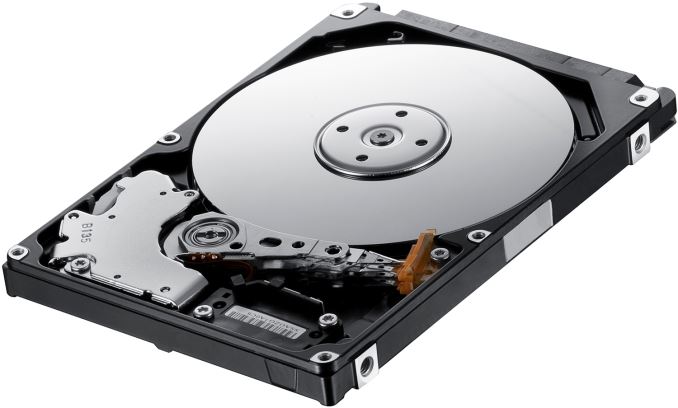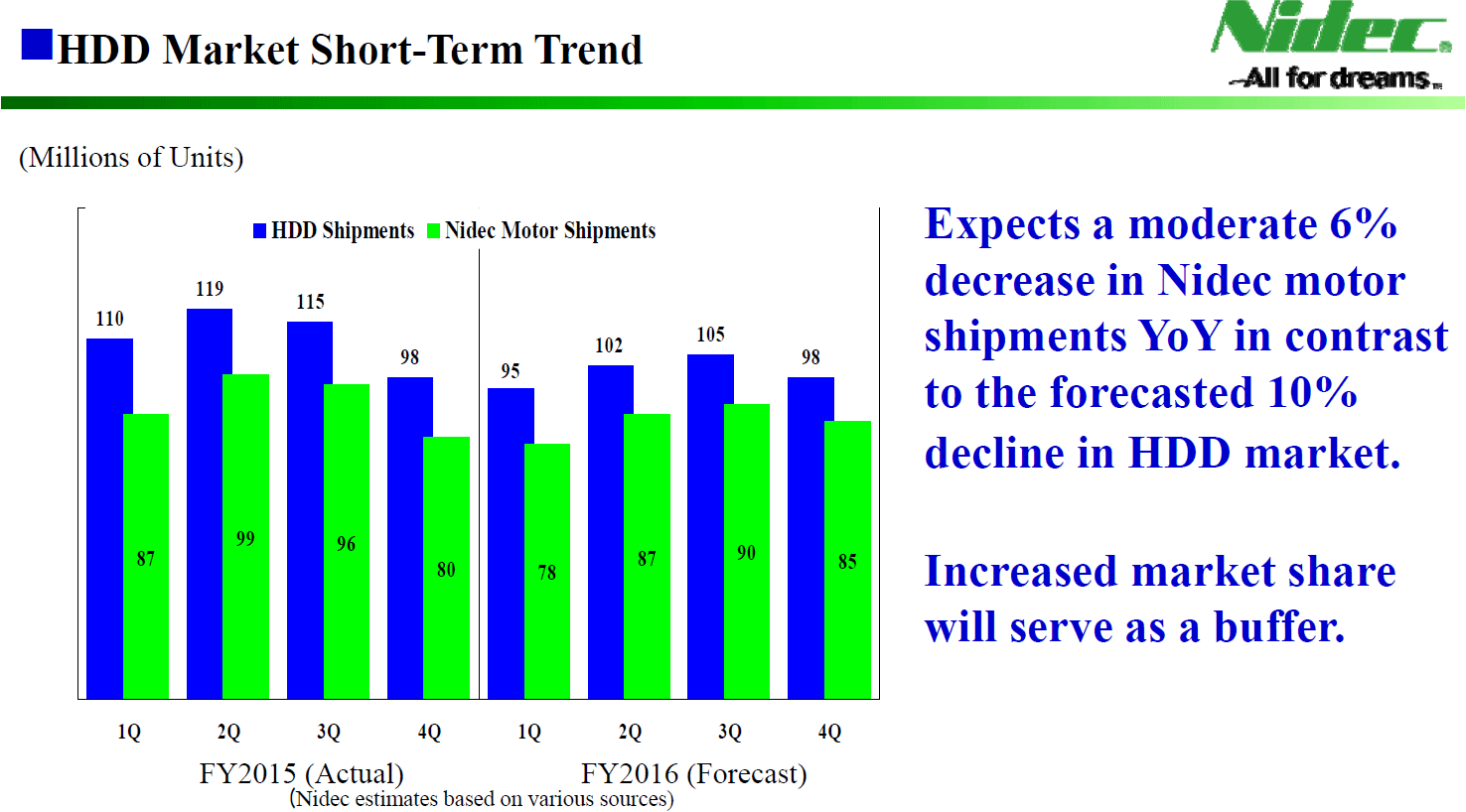Market Views: HDD Shipments Down 20% in Q1 2016, Hit Multi-Year Low
by Anton Shilov on May 12, 2016 8:00 AM ESTFinal Words
The storage market in the first quarter of 2016 performed in accordance with the PC market trends in general. Shipments of HDDs went down, but sales of high-capacity nearline hard drives remained a bright spot in the reports of leading hard drive suppliers. Western Digital remains optimistic in the short term for HDDs, but Seagate detailed plans to severely cut its production capacities and to reduce its presence the market of low-end mobile HDDs.
As ultra-thin notebooks, as well as 2-in-1 hybrid PCs, are gaining market share, the potential for 2.5” client HDDs suffers. Theoretically, sales of 2.5” drives for AIO and small form-factor desktops could offset declines in the mobile (at the expense of 3.5” HDDs declines), but this did not happen in Q1: sales of Seagate’s 2.5” client HDDs dropped to 10.6 million units (down 37% YoY), whereas shipments of Western Digital’s 2.5” client drives declined to 13.577 million units (down 28% YoY).
This quarter Seagate announced plans to discontinue some of its 2.5” low-capacity (500 GB and lower) client drives and concentrate on promoting 1 TB and 2 TB 2.5” models based on its latest technologies. Basically, Seagate no longer wants to compete against entry-level TLC NAND-based SSDs in low-end and mainstream notebooks. Reducing participation in this market segment will allow Seagate to simplify the portfolio of components it purchases from other makers and cut down its costs as high-capacity platters for advanced drives are made mostly in-house. It will be very interesting to see how other HDD makers respond to this action. They face similar problems and eventually it will only get harder to compete against cheap SSDs.
Shipments of 3.5” client hard drives hit a new low in the first three months of this year, which was not completely surprising, given slow shipments of PCs. So far neither Seagate nor Western Digital has announced plans to optimize their 3.5” lineups (WD actually folded its Green drives into its Blue lineup last year), but this is something that will likely happen in the future.
Enterprise HDD business is a mixed bag these days. On the one hand, sales of 10K and 15K HDDs are declining because of SSDs and that decline has yet to bottom out. Yet, those hard disks remain expensive and the business overall is profitable. On the other hand, sales of nearline drives are on the rise. More importantly, the growth of average capacities of such HDDs even outpaces the growth in their unit sales. Interestingly, Seagate indicated that demand for high-end 8 TB nearline HDDs was so strong in Q1 2015 that it could not even fulfill the orders placed. Seagate’s rather unexpected start of 10 TB HDD revenue shipments in April proves that operators of data center are rapidly building up capacities.
Seeing the fact that HDD sales volumes have been falling for many quarters now, Seagate not only decided to exit the market of low-end notebook drives but also detailed its plans to steeply cut-down its manufacturing capacities to 35 – 40 million units per quarter from 55 – 60 million units per quarter. From now on, the company will focus on high-capacity HDDs that are sold at higher prices rather than on affordable drives for bulk storage, which will naturally help it to avoid direct competition against SSDs in the entry-level segment where capacity may not be that important. It remains to be seen what Seagate will do with the manufacturing equipment that it will not need after its optimizations, but that is a different conversation entirely.
Looking ahead, Western Digital believes that the HDD TAM will remain above a psychologically important 400 million units per year mark (shipments of HDDs last year were around 453.6 million units), but will drop in the long term. Meanwhile, Nidec conservatively predicts that HDD TAM will fall to 400 million units in 2016 with shipments of PC and external HDDs declining the most. The upcoming quarters will show whether optimistic or conservative predictions are applicable to today’s HDD market.
Methodology and Important Notices
There are three major manufacturers of hard drives today: Seagate, Toshiba and Western Digital. Other suppliers are reselling hard drives made by these three companies.
Seagate and Western Digital reveal their HDD unit shipments as well as TAM (total available market) estimates every fiscal quarter. While such numbers are considered preliminary, they are usually rather accurate and re-affirmed by third-party analysts. Our TAM is the midpoint between Seagate’s and Western Digital’s TAM estimates. If only one hard drive maker reveals its TAM, we consider the number from only one vendor.
Meanwhile Toshiba does not officially disclose its HDD shipments. We subtract quarterly shipments of Seagate and Western Digital from our TAM estimate to get the number of drives sold by Toshiba. The approach is is the reason why we do not report historical shipments of Toshiba prior to Q3 2012. Based on estimates of hard drive makers and industry observers, Toshiba cannot produce more than 22 – 23 million of HDDs per quarter.
Seagate’s and Western Digital’s fiscal quarters end on the last business day of the last week of a calendar quarter (e.g., the Friday next to December 31). While fiscal quarters of HDD makers may not correspond exactly to calendar quarters, they are very close. Fiscal years of Seagate and Western Digital do not correspond to calendar years as they begin in July.
Historical TAM data comes from financial reports of Seagate and Western Digital.
Note 1: Seagate completed the acquisition of Samsung’s HDD business in December, 2011. The company started to include sales of Samsung-branded HDDs in its quarterly shipments in Q1 2012 (Q3 FY2012).
Note 2: Western Digital closed the acquisition of Hitachi Global Storage Technologies in March, 2012. Western Digital began to include HGST shipments in its financial reports in Q2 2012 (Q4 FY2012).
Note 3: Toshiba acquired some of Western Digital’s 3.5-inch HDD manufacturing equipment and intellectual property in May, 2012. It was expected that the manufacturing transfer could be complete within 6 to 12 months. Western Digital made HDDs for Toshiba on a contract basis until late Q4 2012. Due to the contract manufacturing agreement between Western Digital and Toshiba in 2012, there may be some inaccuracies in the historical data in that period (i.e., since the drives were made by Western Digital and then sold to Toshiba, they are attributed to the former, not the latter).
Note 4: Seagate defines client HDDs as 2.5” and 3.5” hard drives for desktops, notebooks and hybrid PCs as well as game consoles. Seagate considers HDDs for external storage and network-attached storage (NAS) as “branded” drives. Hard disks for DVRs and surveillance systems belong to Seagate’s family of HDDs for consumer electronics. Enterprise lineup includes 2.5” and 3.5” drives for mission critical (SAS, SCSI, Fibre Channel), enterprise storage, nearline and other datacenter applications.
Note 5: Western Digital attributes desktop and mobile 2.5” and 3.5” hard drives to client HDDs. External hard drives and NAS are referred to as “branded products”. Western Digital’s consumer electronics HDDs are used in DVRs, game consoles, video streaming applications and security video recording systems.












116 Comments
View All Comments
Gothmoth - Thursday, May 12, 2016 - link
HDD´s drop dead like flies... no wonder nobodys want´s to buy that crap.seagate is replacing my 3 month old 4TB drive with a FACTORY REPAIRED drive.
i did not pay for a second hand drive!!!
WD is not much better.
seagate cheats their customers with their crappy warranty.
jwcalla - Thursday, May 12, 2016 - link
I agree. It's one of the reasons I'm hesitant to buy any. Most of them are complete junk.SirGCal - Friday, May 13, 2016 - link
Test your drives before use. Especially Seagates. Their build practices frighten me. I have 8 4TB drives, and went through 22 drives before I got 8 that passed the tests... THAT is scary. But they've been running since release without further issues. I hear they are far better now but I still test each one before using it.jbrizz - Sunday, May 15, 2016 - link
You can probably thank weak consumer protection laws for that. In AU and NZ (and probably UK and other parts of Europe) they don't do that because it's not legal.svan1971 - Thursday, May 12, 2016 - link
The price has not gone down though...sonicmerlin - Thursday, May 12, 2016 - link
That's because the $/GB has barely budged since what it was at before the 2011 flood. I remember routinely seeing 3 TB internal HDDs going on sale for $80 before the flood.Then the HDD vendors all merged and jacked up prices while massively slowing down aerial density innovations.
SirGCal - Friday, May 13, 2016 - link
Hu? They are up to 10TB drives now in test cases and 8TB regularly purchasable... It's only 2016. Plus the cost of components has changed. I'd consider the 2011 pre-flood an all time low, rather amazing prices then a norm to aim for... Still I never saw a 3TB drive I'd buy, let alone one for that price.Burns101 - Thursday, May 12, 2016 - link
HDDs are only good for porn and movies!iwod - Thursday, May 12, 2016 - link
You can now get a very decent Plextor M7V ( TLC Based ) or SanDisk SSD Plus ( MLC Based ), both with decent Controller and Firmware support for less then $40 with 128GB.I expect the price to stay put, in 2017 once all the Fab from China and New Fab from Samsung are up, we will likely see 256GB SSD going for $40 in 2018. That should be the point where most people are fine with SSD in terms of capacity.
stevenrix - Friday, May 13, 2016 - link
The hard-drive market going down sounds like a predictive failure from their own technical jargon.It was worth mentioning that the price per gig on the hard-drives won't go down, which means that at some point in time, when the prices of the hard-drive will go up according to their bigger capacity (10 Tb, 12 Tb ...etc) and the price of the SSDs going down, then it will make it easier to switch to SSDs. In other words their strategy won't resist that much in time. Also if prices since the flood in Thailand have not much fluctuated on the hard-drives makers, the cost on the consumer went from 1 to 3 for the same hard-drive capacity. A few days before the flood I had bought around 20 Tb of drives for a few hundreds of dollars, and i have never seen those prices going back to those prices and it probably will never go back to that trend.
At a consumer level, I am willing to upgrade to 8Tb drives, but those prices are too expensive. I am pretty sure that many consumers are waiting to upgrade to bigger drives and are waiting to see the prices getting slashed. Worse case scenario I will keep buying 4 Tb drives. It is the enterprise market that help the hard-drives makers to survive, especially in the NAS enterprise market (a SAS 6 15K drive costs so much money). Maybe they should not cut production, but help to replace failed hard-drives with newer hard-drives instead of refurbished drives that will fail again in a few weeks/months to raise customer's satisfaction, because customer's satisfaction dropped to low levels a few years ago. Please make the customer happy first and they'll start buying again hard-drives. Thanks ;)